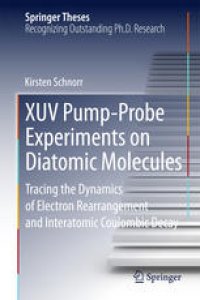
Ebook: XUV Pump-Probe Experiments on Diatomic Molecules: Tracing the Dynamics of Electron Rearrangement and Interatomic Coulombic Decay
Author: Kirsten Schnorr (auth.)
- Tags: Atoms and Molecules in Strong Fields Laser Matter Interaction, Optics and Electrodynamics, Spectroscopy and Microscopy, Medical and Radiation Physics
- Series: Springer Theses
- Year: 2015
- Publisher: Springer International Publishing
- Edition: 1
- Language: English
- pdf
This book explores the relaxation dynamics of inner-valence-ionized diatomic molecules on the basis of extreme-ultraviolet pump-probe experiments performed at the free-electron laser (FEL) in Hamburg. Firstly, the electron rearrangement dynamics in dissociating multiply charged iodine molecules is studied in an experiment that made it possible to access charge transfer in a thus far unexplored quasimolecular regime relevant for plasma and chemistry applications of the FEL. Secondly the lifetime of an efficient non-radiative relaxation process that occurs in weakly bound systems is measured directly for the first time in a neon dimer (Ne2). Interatomic Coulombic decay (ICD) has been identified as the dominant decay mechanism in inner-valence-ionized or excited van-der-Waals and hydrogen bonded systems, the latter being ubiquitous in all biomolecules. The role of ICD in DNA damage thus demands further investigation, e.g. with regard to applications like radiation therapy.
This book explores the relaxation dynamics of inner-valence-ionized diatomic molecules on the basis of extreme-ultraviolet pump-probe experiments performed at the free-electron laser (FEL) in Hamburg. Firstly, the electron rearrangement dynamics in dissociating multiply charged iodine molecules is studied in an experiment that made it possible to access charge transfer in a thus far unexplored quasimolecular regime relevant for plasma and chemistry applications of the FEL. Secondly the lifetime of an efficient non-radiative relaxation process that occurs in weakly bound systems is measured directly for the first time in a neon dimer (Ne2). Interatomic Coulombic decay (ICD) has been identified as the dominant decay mechanism in inner-valence-ionized or excited van-der-Waals and hydrogen bonded systems, the latter being ubiquitous in all biomolecules. The role of ICD in DNA damage thus demands further investigation, e.g. with regard to applications like radiation therapy.